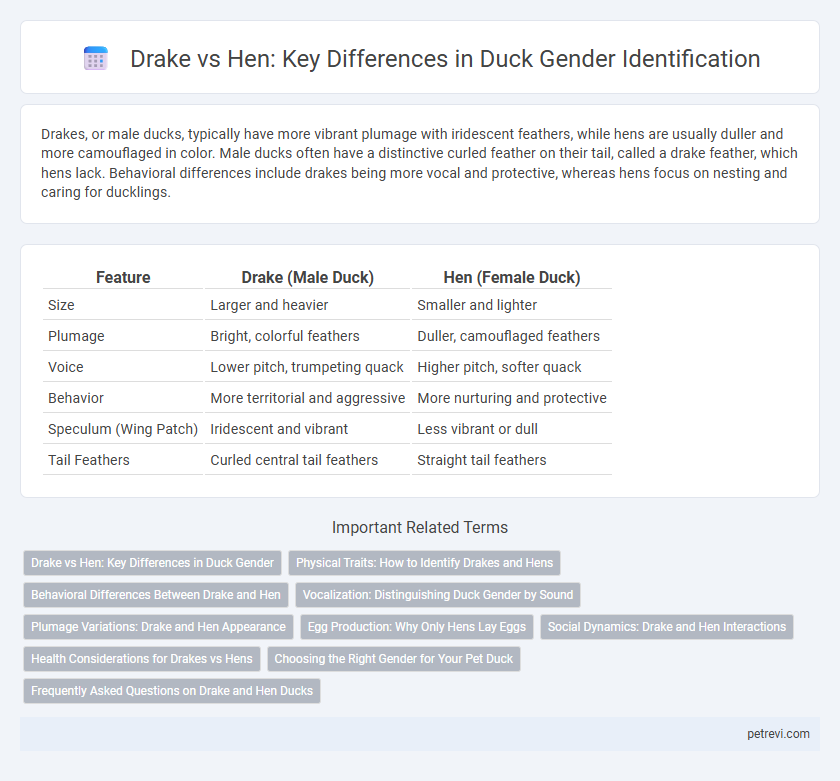Drakes, or male ducks, typically have more vibrant plumage with iridescent feathers, while hens are usually duller and more camouflaged in color. Male ducks often have a distinctive curled feather on their tail, called a drake feather, which hens lack. Behavioral differences include drakes being more vocal and protective, whereas hens focus on nesting and caring for ducklings.
Table of Comparison
| Feature | Drake (Male Duck) | Hen (Female Duck) |
|---|---|---|
| Size | Larger and heavier | Smaller and lighter |
| Plumage | Bright, colorful feathers | Duller, camouflaged feathers |
| Voice | Lower pitch, trumpeting quack | Higher pitch, softer quack |
| Behavior | More territorial and aggressive | More nurturing and protective |
| Speculum (Wing Patch) | Iridescent and vibrant | Less vibrant or dull |
| Tail Feathers | Curled central tail feathers | Straight tail feathers |
Drake vs Hen: Key Differences in Duck Gender
Drakes, the male ducks, are typically distinguished by their vibrant plumage, louder quacks, and larger size compared to hens, the female ducks. Hen ducks possess more muted coloring for camouflage during nesting, softer vocalizations, and generally smaller, streamlined bodies. Behavioral patterns also differ, with drakes often exhibiting more aggressive and territorial tendencies, especially during mating season.
Physical Traits: How to Identify Drakes and Hens
Drakes typically have more vibrant and iridescent plumage, often featuring a bright green head in mallards, while hens display mottled brown feathers for camouflage. Drakes usually possess a thicker neck and a larger, more robust body compared to the smaller, slimmer hens. The presence of a curled feather, called the drake feather, on the tail is a definitive physical trait distinguishing male ducks from females.
Behavioral Differences Between Drake and Hen
Drakes often exhibit more aggressive and territorial behaviors compared to hens, especially during mating season when they compete for dominance. Hens tend to be more nurturing and protective, focusing on nesting and caring for ducklings while displaying less territorial aggression. Vocalizations also differ, with drakes producing quieter, raspier sounds whereas hens emit louder, quack-like calls to communicate and warn of potential threats.
Vocalization: Distinguishing Duck Gender by Sound
Drakes produce a lower-pitched, softer quack compared to hens, whose loud, sharp quacks are more frequent and piercing, making vocalization a reliable way to distinguish duck gender. Hens often use their distinct quacking to communicate alarm or attract mates, whereas drakes tend to emit quieter, raspy sounds during courtship. Vocal patterns and sound characteristics serve as key indicators for identifying male and female ducks in various species.
Plumage Variations: Drake and Hen Appearance
Drakes exhibit vibrant plumage with iridescent green heads, bright blue speculum feathers, and bold white neck rings, making them visually distinct from hens. Hen plumage is predominantly mottled brown and tan, providing effective camouflage during nesting. These plumage variations facilitate gender identification and play a role in mating displays within wild and domestic duck populations.
Egg Production: Why Only Hens Lay Eggs
Only hens lay eggs because they possess the reproductive anatomy necessary for egg production, including functional ovaries and oviducts. Drakes, the male ducks, lack these organs and instead have testes to produce sperm, making them incapable of laying eggs. The hormonal differences between hens and drakes regulate egg formation exclusively in females, ensuring egg production remains a hen's biological function.
Social Dynamics: Drake and Hen Interactions
Drakes often dominate hens within duck social hierarchies, using their larger size and vibrant plumage to establish dominance and attract mates. Hens communicate through subtle vocalizations and body language, influencing group cohesion and nesting site selection. These interactions shape mating success and territorial behaviors crucial to the social structure of duck flocks.
Health Considerations for Drakes vs Hens
Drakes generally have a stronger immune system than hens, making them less susceptible to certain diseases such as duck viral enteritis and avian influenza. However, hens are more prone to reproductive health issues, including egg binding and infections related to egg production. Proper diet and habitat management are crucial for maintaining health in both drakes and hens, with emphasis on calcium intake for hens to support shell formation and overall reproductive health.
Choosing the Right Gender for Your Pet Duck
Choosing the right gender for your pet duck involves understanding the differences between a drake and a hen. Drakes, the male ducks, typically have more vibrant plumage and louder vocalizations, while hens, the female ducks, are generally quieter and better suited for egg-laying. Consider your preferences for behavior and purpose, as hens provide eggs and tend to be calmer, whereas drakes can be more territorial and vocal.
Frequently Asked Questions on Drake and Hen Ducks
Drakes are male ducks typically distinguished by their vibrant plumage and louder quacks, while hens are female ducks known for more muted colors and softer sounds. Frequently asked questions focus on identification traits, such as drakes having curled tail feathers called "drake feathers" and hens usually lacking these features. Understanding these differences helps birdwatchers and farmers accurately determine the gender of their ducks for breeding and care purposes.
Drake vs Hen for Duck Gender Infographic

 petrevi.com
petrevi.com